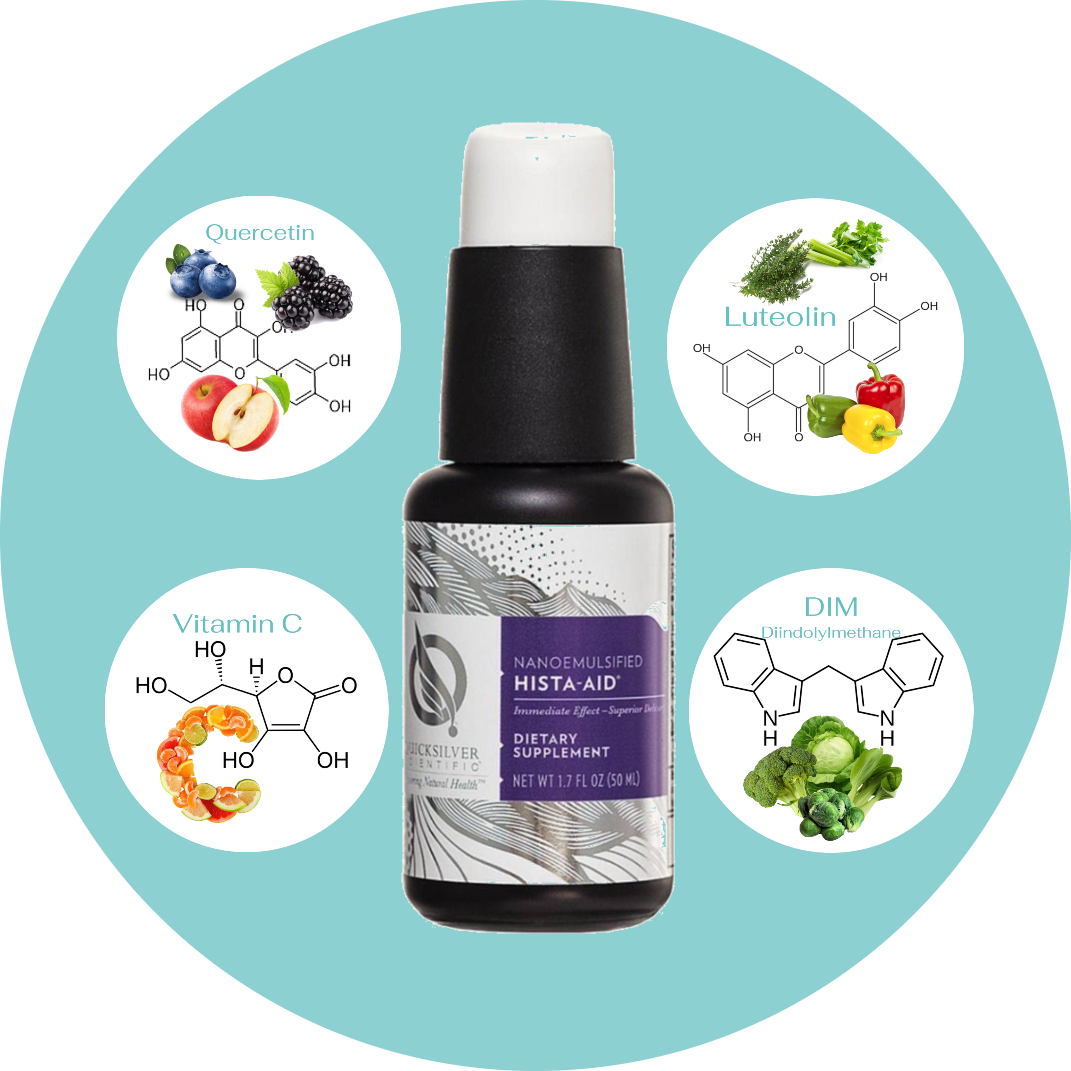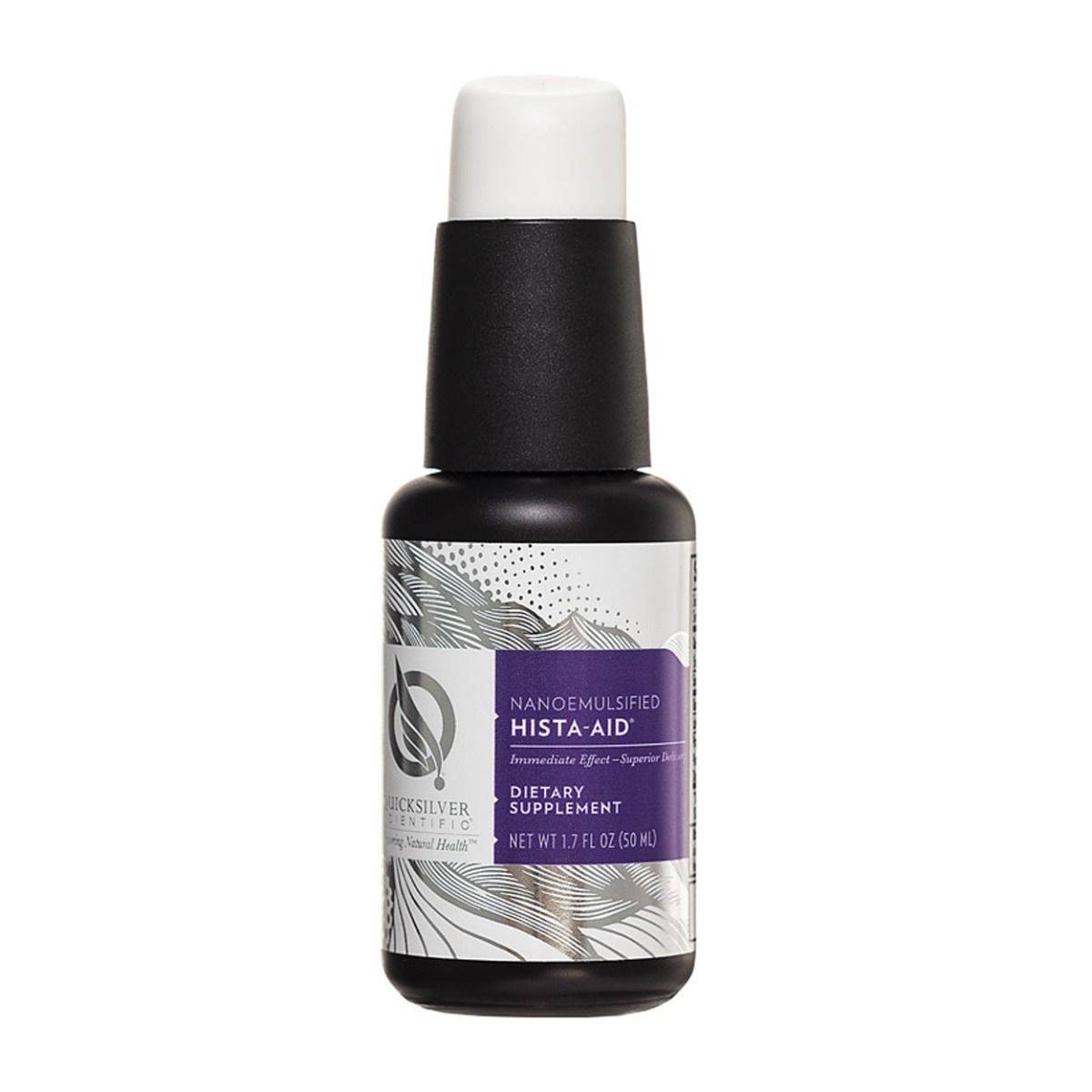Natural antihistamine complex – Hista-Aid
This excellent natural antihistamine complex could be the solution if you have symptoms caused by excess histamine in your body.

The Hista-Aid Natural antihistamine complex can provide dramatic relief by balancing the histamine response. These natural agents offer a safe, effective alternative to decongestants and antihistamines drugs.
Flavonoids are polyphenolic plant compounds ubiquitous in fruits and vegetables. Two flavonoids – quercetin and luteolin – have particularly powerful antihistamine effects.
Hista-Aid the histamine release STOP
Natural antihistamine complex, a targeted blend of nutraceuticals that helps balance histamine production
This unique, natural antihistamine complex consists of the valuable natural ingredients below.
Quercetin
This product is full of excellent components that can break histamine. Quercetin is one of the most effective natural antihistamines. It is found in onions, berries, and apples and inhibits histamine release from mast cells and basophils. It is more effective than Cromolyn sodium, a mast cell-stabilizing drug, for inhibiting the release of histamine and inflammatory cytokines from mast cells! This excellent flavonoid also suppresses the formation of IgE antibodies, which mediate allergic sensitization.
Luteolin
Luteolin found in celery, thyme, and bell peppers, also has potent antihistamine activity. It decreases inflammatory cytokine production and immune cell infiltration in the lungs, balancing the body’s response to environmental allergens.
This natural agent inhibits mast cell degranulation, effectively blocking the release of histamine before it causes allergic symptoms. Experimental studies have shown that luteolin has anti-inflammatory and anti-pruritic effects.
This unique ingredient demonstrated the greatest inhibitory effect of all flavonoids on mast-cell histamine release; it was even more effective than the well-known mast-cell stabilizer quercetin at preventing histamine release.
Mucus attenuation
Luteolin showed a beneficial effect on airway responsiveness, decreasing bronchoconstriction in experimentally induced asthma.
Cytokine modulation
High levels of inflammatory cytokines are present in chronic conditions like asthma and arthritis etc. Luteolin inhibits IgE-mediated production of interleukin-6 (IL-6) and tumor necrosis factor-alpha (TNF-a).
Crossing the blood-brain barrier
Many neuropsychiatric and neurodegenerative disorders, such as multiple sclerosis, Alzheimer’s disease, and even autism spectrum disorder (ASD), are thought to involve inflammation within the brain. Studies show that luteolin crosses the blood-brain barrier and stabilizes T-cell activation as well as mast cells within the brain.
Researchers have suggested that luteolin may help reduce symptoms of brain fog, and it is beneficial in patients with ASD.
Vitamin C
Vitamin C cannot be missing from this natural antihistamine complex. Vitamin C deficiency is associated with an increased risk of allergies because vitamin C rapidly decreases histamine. Vitamin C alleviates histamine excess by destroying the structure of the histamine molecule.
DIM
Diindolylmethane (DIM) is a sulfur-based compound found in cruciferous vegetables and a potent activator of the Nrf2 antioxidant system, and it is beneficial for suppressing allergic lung inflammation.
DIM also decreases histamine by balancing hormones. Estrogen stimulates mast cells to release histamine and downregulates the DAO enzymes responsible for degrading histamine; excess estrogen can trigger allergy symptoms. By balancing estrogen, DIM regulates histamine.
Importantly, xenoestrogens such as BPA and phthalates also exacerbate allergies by influencing histamine activity. DIM has a protective effect against xenoestrogen-induced estrogenic signaling, further balancing the histamine response.
Resources
1
Seelinger G, Merfort I, Schempp CM. Anti-oxidant, anti-inflammatory and anti-allergic activities of luteolin. Planta Med. 2008;74 (14):1667-1677.
2
Kritas SK, et al. Luteolin inhibits mast cell-mediated allergic inflammation. J Biol Regul Homeost Agents. 2013;27 (4):955-959.
3
Iwaoka E, Oku H, Iinuma M, Ishiguro K. Allergy-preventive effects of the flowers of Impatiens textori. Biol Pharm Bull. 2010;33 (4):714-716.
4
Ueda H, Yamazaki C, Yamazaki M. Luteolin as an anti-inflammatory and anti-allergic constituent of Perilla frutescens. Biol Pharm Bull. 2002;25 (9):1197-1202.
5
Jeon IH, et al. Anti-inflammatory and antipruritic effects of luteolin from Perilla (P. frutescens L.) leaves. Molecules. 2014;19 (6):6941-6951.
6
Amellal M, et al. Inhibition of mast cell histamine release by flavonoids and biflavonoids. Planta Med. 1985;51 (1):16-20.
7
Shen ML, et al. Luteolin Attenuates Airway Mucus Overproduction via Inhibition of the GABAergic System. Sci Rep. 2016;6 32756.
8
Das M, Ram A, Ghosh B. Luteolin alleviates bronchoconstriction and airway hyperreactivity in ovalbumin sensitized mice. Inflamm Res. 2003;52 (3):101-106.
9
Leemans J, et al. Prophylactic effects of omega-3 polyunsaturated fatty acids and luteolin on airway hyperresponsiveness and inflammation in cats with experimentally-induced asthma. Vet J. 2010;184 (1):111-114.
10
Kimata M, Inagaki N, Nagai H. Effects of luteolin and other flavonoids on IgE-mediated allergic reactions. Planta Med. 2000;66 (1):25-29.
11
Leyva-López N, et al. Flavonoids as Cytokine Modulators: A Possible Therapy for Inflammation-Related Diseases. Int J Mol Sci. 2016;17 (6).
12
Xia N, et al. Anti-inflammatory effects of luteolin on experimental autoimmune thyroiditis in mice. Exp Ther Med. 2016;12 (6):4049-4054.
13
Theoharides TC, Kempuraj D, Iliopoulou BP. Mast cells, T cells, and inhibition by luteolin: implications for the pathogenesis and treatment of multiple sclerosis. Adv Exp Med Biol. 2007;601 423-430.
14
Theoharides TC, et al. Brain “fog,” inflammation and obesity: key aspects of neuropsychiatric disorders improved by luteolin. Front Neurosci. 2015;9 225.
15
Taliou A, et al. An open-label pilot study of a formulation containing the anti-inflammatory flavonoid luteolin and its effects on behavior in children with autism spectrum disorders. Clin Ther. 2013;35 (5):592-602.
16
Theoharides TC, Asadi S, Panagiotidou S. A case series of a luteolin formulation (NeuroProtek®) in children with autism spectrum disorders. Int J Immunopathol Pharmacol. 2012;25 (2):317-323.
17
Luo Y, Shang P, Li D. Luteolin: A Flavonoid that Has Multiple Cardio-Protective Effects and Its Molecular Mechanisms. Front Pharmacol. 2017;8 692.
18
Ando N, et al. Allergen-specific basophil reactivity exhibits daily variations in seasonal allergic rhinitis. Allergy. 2015; 70(3): 319-322.
19
Weng Z, et al. Quercetin is more effective than cromolyn in blocking human mast cell cytokine release and inhibits contact dermatitis and photosensitivity in humans. PLoS One. 2012; 7(3): e33805.
20
Chirumbolo S, et al. Bimodal action of the flavonoid quercetin on basophil function: an investigation of the putative biochemical targets. Clin Mol Allergy. 2010; 8:13.
21
Mlcek J, et al. Quercetin and its anti-allergic immune response. Molecules. 2016; 21(5): pii: E623.
22
Shaik Y, et al. Impact of polyphenols on mast cells with special emphasis on the effect of quercetin and luteolin. Cent Eur J Immunol. 2018; 43(4): 476-481.
23
Jang TY, et al. Anti-allergic effect of luteolin in mice with allergic asthma and rhinitis. Cent Eur J Immunol. 2017; 42(1): 24-29.
24
Vollbracht C, et al. Intravenous vitamin C in the treatment of allergies: an interim subgroup analysis of a long-term observational study. J Int Med Res. 2018; 46(9): 3640-3655.
25
Carr AC, Maggini S. Vitamin C and immune function. Nutrients. 2017; 9(11): 1211.
26
Pall ML, Levine S. Nrf2, a master regulator of detoxification and also antioxidant, anti-inflammatory, and other cytoprotective mechanisms, is raised by health promoting factors. Acta physiologica Sinica. 2015; 67(1): 1-
27
Nagashima R, et al. Nrf2 suppresses allergic lung inflammation by attenuating the type 2 innate lymphoid cell response. J Immunol. 2019; 202(5): 1331-1339.
28
Thilagavathi S, et al. Protective effect of 3,3-diindolylmethane on bisphenol A activated GPR30, RAS, PI3K/Akt estrogenic signaling pathway in female Sprague-Dawley rats. J Med Toxicol Clin Forensic Med. 2017; 3(1):6.
29
Huang M, et al. Encapsulation of flavonoids in liposomal delivery systems: the case of quercetin, kaempferol, and luteolin. Food Funct. 2017; 8(9): 3198-3208.


